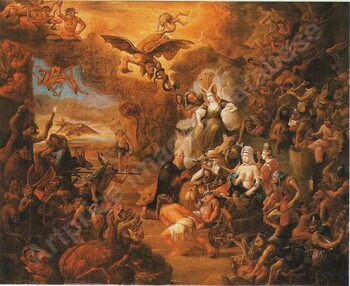Matheus van Helmont
The Temptation of Saint Anthony
Oil on panel : 36,5 X 26,5 cm
Signed lower right “M.v.Helmont”
Sold at Koller Zurich, 22/09/06
For 20.000 CHF (+ buyer’s premium) = 12.592 € (+ buyer’s premium)
This is a comparative item

Painting for Sale
Helmont, Attributed to Matheus van
"The Temptation of Saint Anthony"
In short
Van Helmont stepped in the footsteps of Hieronymus Bosch and of his own17th century Flemish contemporaries David Teniers II and of David Ryckaert III, painting regularly this attractive subject of Saint Anthony being tempted by the Devil under very diverse forms: from monstruous creatures to a graceful nude young woman. An ascetic life as a hermit can indeed create serious hallucinations … .
About Matheus van Helmont
Flemish painter
Antwerp 1623 – after 1679 Brussels
His name is sometimes spelled "Mattheus van Hellemont".
Genre painter of peasant interiors, market scenes and alchemists' workshops, influenced by David Teniers II (Antwerp 1610 – 1690 Brussels) and by David Ryckaert III (Antwerp 1612 – 1661Antwerp).
His portrait groups ("conversation pieces") are often mistaken for those of Gillis van Tilborgh.
As the son of a homonymous, but further unknown painter, van Helmont became Master in the Antwerp Guild of Saint Luke in the year 1645-46. He married in 1649; the couple had four children, all four sons. Two of his children, Jan and Gaspard, became portrait painters.
Van Helmont left Antwerp because of a heavy debt burden and settled in Brussels, where he was recorded in the local guild of painters in 1674. Here he collaborated with Jacques d'Arthois, painting figures in his landscape paintings. He remained in Brussels until his death.
About the Temptation of Saint Anthony
Saint Anthony was born circa 251 in Egypt. We know his life fairly well, thanks to the biography written by his disciple Athanasius.
Round the age of 20 he started a life full of want as a hermit becoming the most famous monk of ancient Christendom. He was a noble example of an ascetic life of austerity, sacrifice and extreme solitude.
The first 35 years he lived retired into solitude in a grotto next to his birthplace, the following 20 years on a mountain on the other bank of the Nile and finally in a community of hermits in an oasis in the desert.
Though he led a hard life, full of deprivation, Anthony was very long-lived: death (which he had predicted) took him at the age of 105, on the 17th of January 355 (or 356). Indeed if one deprives oneself from all that colours life, you may live a very, very, very long monotonous life … .
Saint Anthony became a model for the denial of vice, specifically pleasures of the flesh. During his isolation he had to fight temptation by the devil under different forms, as we can see in this painting.
About our painting
The iconographical theme of the temptation of Saint Anthony goes back to the late Middle Ages, to Hieronymus Bosch.
It was of course a popular theme in Flanders where we can trace a line from Pieter Brueghel I through David Teniers II to David Ryckaert III and to Mattheus van Helmont.
The subject became an excuse for painting an absolutely surreal scenery: all sorts of monstreous creatures try to distract the praying Saint with music, wine and carnal temptation.
Why should you buy this painting?
Because of the marvellously painted Bosch-like crowd of monsters trying to disrupt the serene prayers of Saint Anthony.
Comparative paintings
Click photos for more details





